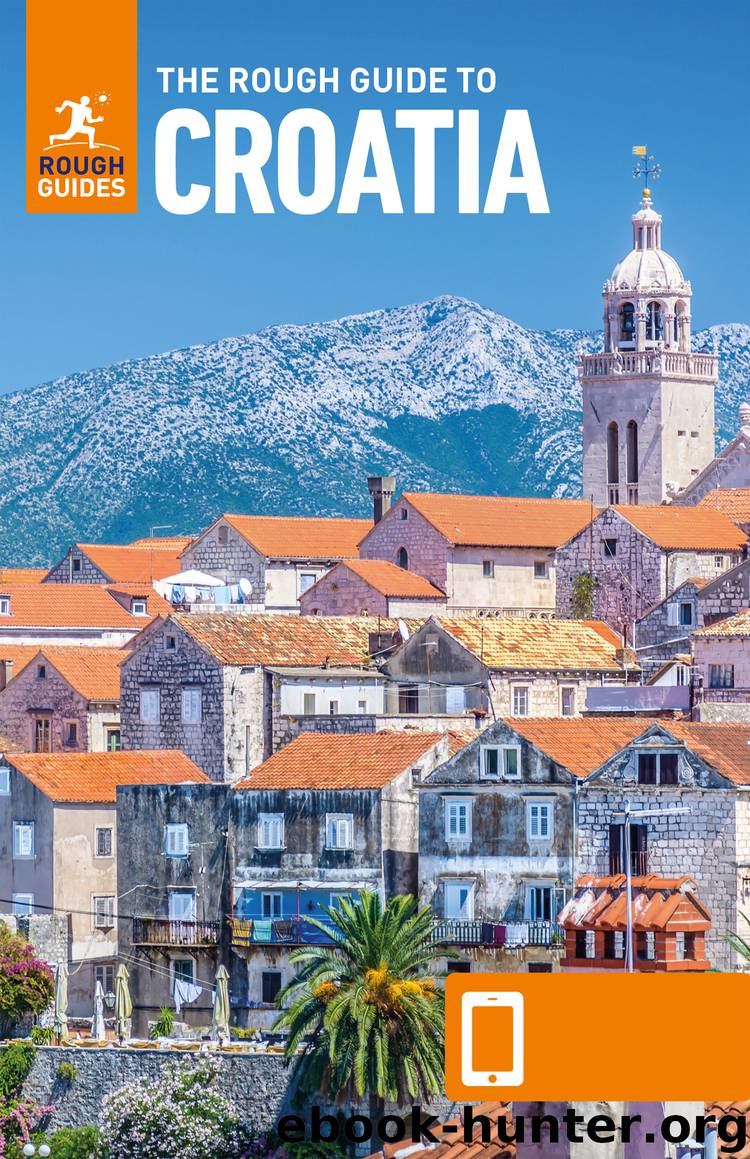The Rough Guide to Croatia (Travel Guide eBook) by Rough Guides

Author:Rough Guides
Language: eng
Format: epub
Tags: Travel, Croatia
Publisher: Apa Publications
Published: 2019-01-10T10:10:15+00:00
Alamy
CHURCH ON SILBA VILLAGE
Northern Dalmatia
Zadar
Nin
The Zadar archipelago
Murter
The Kornati islands
Šibenik
Krapanj
Zlarin and Prvić
Krka National Park
Knin
Primošten
Northern Dalmatia
Compact and easily explored, northern Dalmatia presents a greater concentration of the highlights of Adriatic travel than almost any other part of Croatia. Along the coast are beautifully preserved medieval towns poised above some of the clearest waters in Europe, while offshore are myriad islands adorned with ancient stone villages and enticing coves. The region increasingly serves both as a focus for the party crowd and as a get-away-from-it-all destination, with a burgeoning roster of festivals dovetailing neatly with stirring scenery and soothing beaches.
The main urban centre of northern Dalmatia is Zadar, an animated jumble of Roman, Venetian and modern styles that presents as good an introduction as any to Dalmatia’s mixed-up history. It’s within day-trip distance of the medieval Croatian centre of Nin, and is also the main ferry port for the unassuming islands of Silba, Olib and Dugi otok, where you’ll find peaceful villages, laidback beaches, and a level of tourism that has not yet become an industry.
South of Zadar is Šibenik, site of a spectacular fifteenth-century cathedral and a convenient base for visiting the tumbling waterfalls of the Krka National Park. The other great natural attraction in this part of Dalmatia is the Kornati archipelago, a collection of captivatingly bare islands accessed from the easy-going island of Murter. Joining Murter to the mainland is the swing-bridge at Tisno, a small town that’s become the main venue for the summer-long cycle of festivals run by the Garden organization.
Dalmatia’s long history of Roman, then Venetian cultural penetration has left its mark on a region where children still call adult males barba (“beard” – Italian slang for “uncle”) and respected gents go under the name of šjor (the local version of signore), but modern Dalmatia’s identity is difficult to pin down. People from northern Croatia will tell you that life is lived at a much slower pace in Dalmatia, whose inhabitants are joshingly referred to as tovari (“donkeys”) by their compatriots, though the briefest of visits to bustling regional centres like Zadar will be enough to persuade you that these clichés are somewhat wide of the mark. The Dalmatians themselves will tell you that life is to be enjoyed and should not be hurried – which is why food, wine, music and café life are accorded so much quality time.
Getting aroundNorthern Dalmatia
By bus Frequent buses run up and down the main coastal road, the Jadranska Magistrala, or Adriatic Highway.
By car The Zagreb–Split toll motorway runs several kilometres inland of Zadar and Šibenik, but can still be a quick way of getting from north to south.
By ferry Every inhabited island is connected by some kind of regular local ferry or catamaran, with Zadar serving as the main passenger port. Ferries also ply the Zadar–Ancona route in summer.
Zadar
The ancient capital of Dalmatia, ZADAR is one of the success stories of the Croatian Adriatic, combining ancient and medieval heritage with a bustling café life, a vibrant bar scene and the
Download
This site does not store any files on its server. We only index and link to content provided by other sites. Please contact the content providers to delete copyright contents if any and email us, we'll remove relevant links or contents immediately.
| Atlases & Gazetteers | Historical |
| Travel Maps | United States |
| World |
Goodbye Paradise(3000)
Atlas Obscura by Joshua Foer(2359)
Tokyo by Rob Goss(2028)
Lonely Planet New York City by Lonely Planet(1856)
DK Eyewitness Top 10 Travel Guides Orlando by DK(1826)
Borders by unknow(1797)
Top 10 Dubai and Abu Dhabi by DK Travel(1726)
Tomb of the Panzerwaffe: The Defeat of the Sixth SS Panzer Army in Hungary 1945 by Aleksei Isaev & Maksim Kolomiets(1629)
Rick Steves London 2018 by Rick Steves & Gene Openshaw(1499)
Dirt by Bill Buford(1247)
Atlas of Improbable Places by Travis Elborough(1198)
the fault in our stars by john green(1197)
The Path Between the Seas by David McCullough(1193)
The Travels by Marco Polo(1159)
Tokyo on Foot by Florent Chavouet(1151)
The Lives of Conn Smythe by Kelly McParland(1105)
Need by Unknown(1105)
The Lord of the Rings: The Fellowship of the Ring, the Two Towers, the Return of the King by J. R. R. Tolkien(1089)
Top 10 Israel and Petra by DK Travel(1079)
